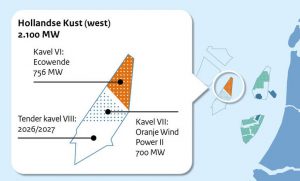Shell and Eneco win tender for 756MW Hollandse Kust (west) site VI
 Ecowende, a joint venture of Shell and Eneco, is the winner of the permit for the Hollandse Kust (west) Site VI offshore wind farm. Ecowende will build the wind farm with an eye for nature. This is one of two new wind farms in the Hollandse Kust (west) Wind Farm Zone and is expected to be commissioned in 2026.
Ecowende, a joint venture of Shell and Eneco, is the winner of the permit for the Hollandse Kust (west) Site VI offshore wind farm. Ecowende will build the wind farm with an eye for nature. This is one of two new wind farms in the Hollandse Kust (west) Wind Farm Zone and is expected to be commissioned in 2026.
The Hollandse Kust (west) Wind Farm Zone – HKWWFZ – is located more than 50km off the Dutch coast near IJmuiden. The wind farm has a capacity of 756MW and consists of 54 wind turbines. These will produce enough electricity each year to meet approximately 3% of the Dutch electricity demand – approximately equal to the consumption of one million households. The wind farm will be realised without subsidy. New to the tenders for the HKWWFZ is that the parties were asked to make a financial offer. Together with the costs for the environmental impact assessments and location studies that are being paid by Ecowende, this yields about USD 67.4 million. That amount is used to ensure wind farms are designed with due care to the environment and other activities in the North Sea. Minister for Climate and Energy Policy, Rob Jetten, says, “The plan presented by Ecowende shows what we can do to design wind farms that work with nature. They can go well together. And that is necessary because there will need to be many more offshore wind farms to be able to supply sufficient green energy. With 40 innovative experiments and applications in this proposal, we are starting a movement to build offshore wind farms with minimal impact on nature.”
‘Ecology’ was included as an additional criterion in the assessment of the applications for the Site VI permit. Maintaining a healthy ecosystem and biodiversity in the North Sea is of great importance. The aim is to build an offshore wind farm with a thriving ecosystem and with as little impact as possible on nature and the environment. The design of the winning wind farm is ‘nature-inclusive’, including a section where wind turbines are widely spaced so that birds can fly between them safely. Various piling techniques are used to measure and minimise the impact on marine habitats. By placing reef structures on the seabed, marine biodiversity is boosted. In order to test the effectiveness of this in the interim, an expert advisory group will be consulted and knowledge actively shared so it can be used for future wind farms.
Combined, all the offshore wind farms planned in the Dutch North Sea will meet around 75% of the Netherlands’ electricity needs around 2030. This year, the Government raised the ambition for offshore wind to approximately 21GW by around 2030. Currently, approximately 2.5GW of offshore wind has been fully commissioned in the Netherlands and a number of wind farms are under construction or licensed. The Offshore Wind Energy Roadmap 2030 outlines how and when the designated wind farm zones will be developed for the period 2024 – 2031. The Netherlands Enterprise Agency (RVO) and an independent expert committee assessed the applications received.






